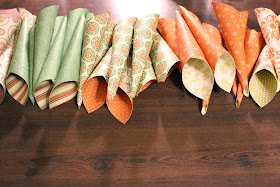You've seen them, right? Those lovely paper cone wreaths all over Pinterest? We even made them at our church's Advent Workshop last year using old, damaged hymnals.
Recently I was tidying up in the art room and unearthed an unopened package of heavy, double-sided, Autumn-colored printed paper. It screamed, "Create a wreath with me!" So I did!
I first cut the 12"x12" papers into 6"x6" squares. With a long-practiced move, I shaped each square into a cone, securing the cone with dabs of hot glue. If you do this, do be careful not to burn your tender fingertips. (I should add that I have adhesive issues... Hi, my name is Donna Rae, and I have adhesive issues... so I, of course, added some thick tacky glue along with the hot glue to ensure a 'stuck-till-Jesus-returns' bond.)
I laid the paper cones out, sorted by color, in the order I wanted to add them to the wreath form.
Speaking of the wreath form... it's a very high-tech, complicated contraption: a circle cut from cardboard that was destined for the compost bin or my husband's next lasagna gardening adventure. I used a salad plate to trace the circle, cut it out, and penciled a smaller circle in the center.
I was ready! I added swaths of thick tacky glue to a portion of the wreath form, applying it between the edge of the inner penciled circle and the cut edge of the wreath form. As I added each paper cone, I would apply a couple of dots of hot glue to the wreath form in the place where the cone would be laid. (Again, I have adhesive issues. But really, the hot glue gives you that immediate hold, keeping the cone in place while the thick tacky glue dries over time. I find that items held with just hot glue can 'pop off' over time, especially if an item is in the sun, like, say, between a front door and a storm door.) The paper cone was laid in place quickly, glued seam to the back, with the tip touching the edge of the inner penciled circle, not all the way to the center of the wreath form. This allows the 'give' for the paper cones to line up nicely around the circle. I continued, adding the cones around the circle in color-order to give even color distribution around the wreath. (I didn't want 5 green cones on one side and no green cones on the other side.)
I then added a second layer of cones on top of the first layer to add volume and to cover any gaps. I arranged the tips of these second-layer cones closer to the center as I added them, allowing the flares of the first-layer cones to be visible behind them.
Now for that hideously blank center... I took some burlap ribbon, ran a running stitch along one of the long edges, and gathered it into a circle. I double-glued (hot and tacky) a lovely metal "Autumn" sign atop the burlap (I found it at a local craft store on sale, less than $2.) The burlap/sign combo was then double glued to the center of the paper cone wreath.
But how to hang it? Simple! I turned the wreath over, glued on a strip of gingham ribbon, and a deckle-edged circle of printed paper over that, to the cardboard wreath form. Yay! A wreath!
It's a colorful and welcoming addition to our front door for Autumn!



































































